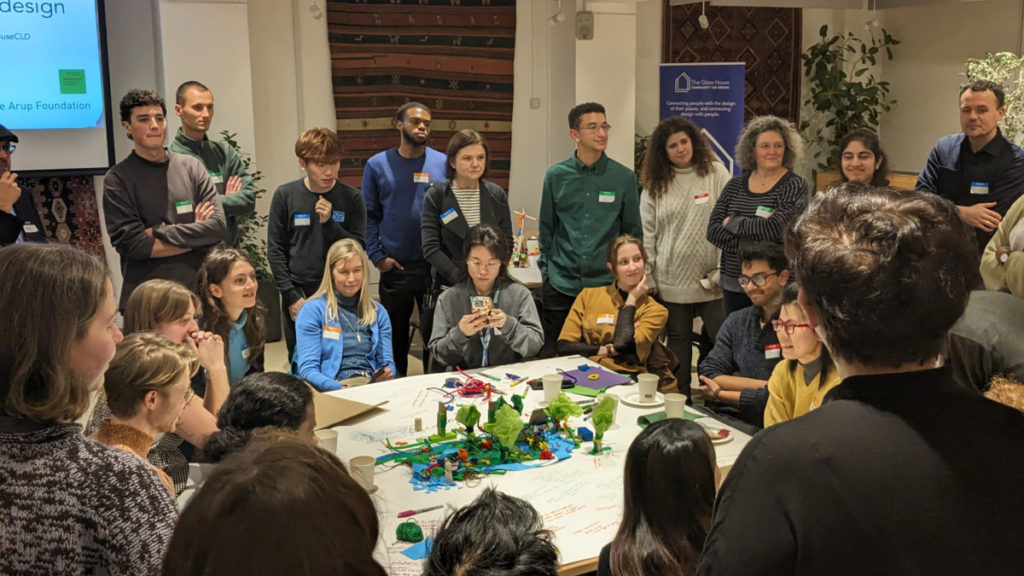Written by:
By Shuqi (Chloe) Miao
Shuqi Miao, a Sustainable Urbanism Masters student from UCL, gives her point of view about taking part in the London WEdesign event at Alan Baxter Gallery, in February.
As a master student at UCL’s Bartlett School of Planning, I have always been interested in climate change, the urban issues it causes, and related place making. I was very lucky to participate in the WEdesign event held by The Glass-House as a student volunteer.
This event is the first live event in this year’s WEdesign series “People Place, Planet“. It is located at the Alan Baxter Gallery in London, with different backgrounds and people with different professions, identities, and cognitions come together to discuss Inclusive Crisis Recovery and collaboratively think and design coping strategies.

As a volunteer, I am responsible for setting up the venue with other volunteers and the organizer before the event, preparing food and drinks, conceiving in advance the theoretical framework and issues to be discussed during the event, and putting my name tags on clothes for convenience. Communicate with the public, lead discussions at events, and clean up after events.
The theme I am responsible for is ecology. My team members and I prepared three questions for the event:
1. What is the relationship between nature & humans?
2. Could you think of an example where ecology/nature has been considered in the built environment?
3. Any personal experiences with the climate crisis?

As the public arrived, we guided guests to their seats and briefly exchanged ideas before the event officially began. We started to discuss the issues enthusiastically in sequence, and I served as a volunteer to guide the progress of the issues, add professional ideas, and encourage public thinking and speech. In each round of speeches, almost all the guests at the table could share their own views and experiences on ecological design, such as rewilding, Passivhus, vertical greening, etc. The collision of different thinking modes and backgrounds created brilliant sparks of thought, which I particularly liked. This is a brainstorming session where ideas collide. At that moment, I enjoyed the blending of different ages, different professional knowledge, and different experiences. I was surprised and moved that there were so many thoughtful and capable people paying attention to and saving our planet.
But it is far from enough to express it with words and illustrations. The intellectual giant we have condensed needs to be born through a more visual expression method. Therefore, the highlight of this event came – manually building models through collaborative design. Our group celebrates following nature, returning to nature, and embracing nature. The relationship between man and nature must not be defined from a dichotomous perspective. Therefore, the characteristics of our collaborative design output are that there are no boundaries, the city is composed of trees and water, and the house is lowered. The density and height reduce the encroachment of vehicles and concrete into the city, and the streets focus more on the experience of walkers and cyclists. In the cities we design, people are not the protagonists, nature is. All things grow and the world prospers. In this way, everyone jointly created an ecological city through the collision of ideas and collaborative design.
Afterwards, team members at each desk explained the theoretical framework and design principles of each topic in sequence. Not only about ecology, I also learned a lot of new ideas about practice, community, and education.

What I like most is the stage of building the model together. We visualize the ideas, just like the characters in the book penetrate the paper and come to the three-dimensional world. What a romantic practice this is! But this part is also the most challenging. The collision of opinions is very simple, but the design output requires the unity of the underlying logic. I guide the public to build the urban framework step by step, and finally add some different creative designs for each person. Fortunately, the public has been very polite and cooperative, and we have been able to work together very smoothly.
Through this activity, I was deeply inspired by the co-design methodology. In my UCL project, I plan to apply it as a research methodology. This is my biggest gain. In future studies, I may combine the two methodologies of co-design and participatory action research to design places, collide with more ideas, and let the principles of sharing, respect, and exchange run through the design, and jointly create a more sustainable environment.
About the Author
Shuqi (Chloe) Miao | Sustainable urbanism master at UCL| wildlife lovers | urban planner & designer | www.linkedin.com/in/chloe-miao-256b392a1

